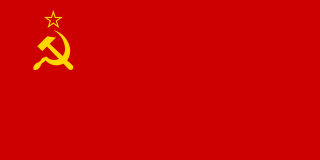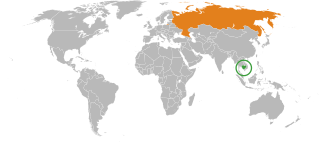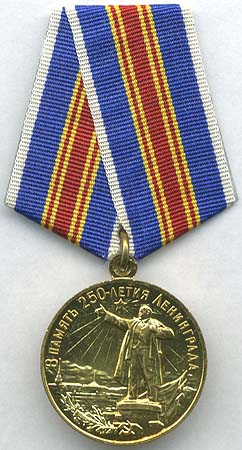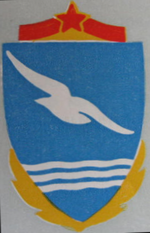
The Soviet Union, officially the Union of Soviet Socialist Republics (USSR), was a transcontinental country that spanned much of Eurasia from 1922 to 1991. A flagship communist state, it was nominally a federal union of fifteen national republics; in practice, both its government and its economy were highly centralized until its final years. It was a one-party state governed by the Communist Party of the Soviet Union, with the city of Moscow serving as its capital as well as that of its largest and most populous republic: the Russian SFSR. Other major cities included Leningrad, Kiev, Minsk, Tashkent, Alma-Ata, and Novosibirsk. It was the largest country in the world, covering over 22,402,200 square kilometres (8,649,500 sq mi) and spanning eleven time zones.

The Order of the Red Banner was the first Soviet military decoration. The Order was established on 16 September 1918, during the Russian Civil War by decree of the All-Russian Central Executive Committee. It was the highest award of Soviet Russia, subsequently the Soviet Union, until the Order of Lenin was established in 1930. Recipients were recognised for extraordinary heroism, dedication, and courage demonstrated on the battlefield. The Order was awarded to individuals as well as to military units, cities, ships, political and social organizations, and state enterprises. In later years, it was also awarded on the twentieth and again on the thirtieth anniversary of military, police, or state security service without requiring participation in combat.

Nikolai Mikhailovich Shvernik was a Soviet politician who served as the Chairman of the Presidium of the Supreme Soviet from 19 March 1946 until 15 March 1953. Though the titular Soviet head of state, Shvernik had less power than Joseph Stalin as Chairman of the Council of Ministers of the Soviet Union.

Gosbank was the central bank of the Soviet Union and the only bank in the entire country from 1922 to 1991. Gosbank was one of the three Soviet economic authorities, the other two being "Gosplan" and "Gossnab". The Gosbank closely collaborated with the Soviet Ministry of Finance to prepare the national state budget.

Awards and decorations of the Soviet Union are decorations from the former Soviet Union that recognised achievements and personal accomplishments, both military and civilian. Some of the awards, decorations, and orders were discontinued after the dissolution of the Soviet Union, while others are still issued by the Russian Federation as of 2021. Many of the awards were simply reworked in the Russian Federation, such as the transition of Hero of the Soviet Union to Hero of the Russian Federation, and Hero of Socialist Labour to Hero of Labour of the Russian Federation. A wide range of Soviet awards and decorations cover the extensive and diverse period of history from 1917 to 1991.

The Order of the Red Star was a military decoration of the Soviet Union. It was established by decree of the Presidium of the Supreme Soviet of the USSR of 6 April 1930 but its statute was only defined in decree of the Presidium of the Supreme Soviet of the USSR of 5 May 1930. That statute was amended by decrees of the Presidium of the Supreme Soviet of the USSR of 7 May 1936, of 19 June 1943, of 26 February 1946, of 15 October 1947, of 16 December 1947 and by decree No 1803-X of 28 March 1980.

The Order of the Red Banner of Labour was an order of the Soviet Union established to honour great deeds and services to the Soviet state and society in the fields of production, science, culture, literature, the arts, education, sports, health, social and other spheres of labour activities. It is the labour counterpart of the military Order of the Red Banner. A few institutions and factories, being the pride of Soviet Union, also received the order. The Order of the Red Banner of Labour was the third-highest civil award in the Soviet Union, after the Order of Lenin and the Order of the October Revolution.
Creative unionsin the Soviet Union were voluntary societies that united Soviet citizens according to their creative (artistic) occupations. They were similar to Soviet trade unions; more specifically, in Soviet ideology and law they were a subset of trade unions, because creative professionals were officially a type of worker. Unofficially, many of their members differentiated themselves culturally from blue-collar workers.
Voluntary Sports Societies (VSS) of the USSR were the main structural parts of the universal sports and physical education (fitness) system, that existed in the USSR between 1935 and 1991, together with already well established Dinamo, society in cooperation with Army, Aviation, and Fleet (DOSAAF), and CSKA sports societies, all of which were classified as Departamental Sports Societies (DSS) of the USSR (DSS-USSR).

Soviet Union–United States relations were fully established in 1933 as the succeeding bilateral ties to those between the Russian Empire and the United States, which lasted from 1776 until 1917; they were also the predecessor to the current bilateral ties between the Russian Federation and the United States that began in 1992 after the end of the Cold War. The relationship between the Soviet Union and the United States was largely defined by mistrust and tense hostility. The invasion of the Soviet Union by Germany as well as the attack on the U.S. Pacific Fleet at Pearl Harbor by Imperial Japan marked the Soviet and American entries into World War II on the side of the Allies in June and December 1941, respectively. As the Soviet–American alliance against the Axis came to an end following the Allied victory in 1945, the first signs of post-war mistrust and hostility began to immediately appear between the two countries, as the Soviet Union militarily occupied Eastern European countries and turned them into satellite states, forming the Eastern Bloc. These bilateral tensions escalated into the Cold War, a decades-long period of tense hostile relations with short phases of détente that ended after the collapse of the Soviet Union and emergence of the present-day Russian Federation at the end of 1991.

Cambodia–Russia relations are the bilateral relations of Cambodia and Russia. The relations between both countries were strong since the Soviet era. Russia has an embassy in Phnom Penh. Cambodia has an embassy in Moscow. Both countries are full members of the East Asia Summit.

Rugby union in the Soviet Union was a moderately popular sport. It was most popular in the Georgian SSR; parts of the Russian SFSR such as Moscow and certain regions in Siberia like Krasnoyarsk; and Alma-Ata, the capital of the Kazakh SSR. Rugby enjoyed a more limited popularity in the Ukrainian SSR, Minsk in the Byelorussian SSR and parts of the RSFSR such as Leningrad and areas in Southern Russia, including Krasnodar. Rugby gained a significant following due to the vast size of the Soviet Union, but was never a major sport; despite many attempts to develop the sport, which Soviet citizens came to nickname the "leather melon" due to the shape of the ball. Still, an early championship in 1960 gives an idea of the sheer scale of Soviet rugby: one hundred teams from over thirty cities took part.

The Russian Soviet Federative Socialist Republic, previously known as the Russian Soviet Republic and the Russian Socialist Federative Soviet Republic, as well as being unofficially referred to as Soviet Russia, the Russian Federation, or simply Russia, was an independent federal socialist state from 1917 to 1922, and afterwards the largest and most populous Soviet socialist republic of the Soviet Union (USSR) from 1922 to 1991, until becoming a sovereign part of the Soviet Union with priority of Russian laws over Union-level legislation in 1990 and 1991, the last two years of the existence of the USSR. The Russian SFSR was composed of sixteen smaller constituent units of autonomous republics, five autonomous oblasts, ten autonomous okrugs, six krais and forty oblasts. Russians formed the largest ethnic group. The capital of the Russian SFSR and the USSR as a whole was Moscow and the other major urban centers included Leningrad, Stalingrad, Novosibirsk, Sverdlovsk, Gorky and Kuybyshev. It was the first Marxist-Leninist state in the world.

The Central Television of the USSR was the state television broadcaster of the Soviet Union.

The Government of the Soviet Union, formally the All-Union Government of the Union of Soviet Socialist Republics, commonly abbreviated to Soviet Government, was the executive and administrative organ of state in the former Soviet Union. It had four different names throughout its existence; Council of People's Commissars (1923–1946), Council of Ministers (1946–1991), Cabinet of Ministers and Committee on the Operational Management of the National Economy. It also was known as Workers-Peasants Government of the Soviet Union during the Stalin era.
The year 1957 was marked by many events that left an imprint on the history of Soviet and Russian fine arts.

The Medal "In Commemoration of the 250th Anniversary of Leningrad" was a state commemorative medal of the Soviet Union established by decree of the Presidium of the Supreme Soviet of the USSR on May 16, 1957 to commemorate the 250th anniversary of the city of Leningrad. It was awarded to prominent members of Soviet society including veterans of the Great Patriotic War and serving members of the armed forces for wartime and peacetime services to the Hero-City of Leningrad.

The Jubilee Medal "40 Years of the Armed Forces of the USSR" was a state military commemorative medal of the Soviet Union established on December 18, 1957 by decree of the Presidium of the Supreme Soviet of the USSR to denote the fortieth anniversary of the creation of the Soviet Armed Forces. Its statute was later amended by decree of the Presidium of the Supreme Soviet of the USSR of July 18, 1980.

The Medal "For Impeccable Service" was a Soviet military award for long service awarded to deserving members of the military personnel of the armed forces of the USSR, of the Interior Ministry of the USSR and of the Ministry for the Protection of Public Order of the USSR, to recognise ten, fifteen and twenty years of faithful and impeccable service to the state.
The State Committee of Television and Radio Broadcasting of the Soviet Union commonly known as Gosteleradioof the USSR was the main state body of that supervised over all television and radio broadcasting of the Soviet Union from September 10, 1931 to December 27, 1991.














